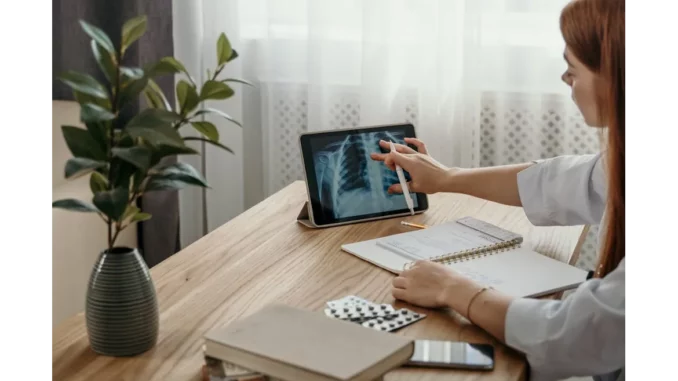
Navigating the intricate landscape of medical imaging technology frequently resembles traversing a labyrinth of innovation and precision. Recently, I had the opportunity to engage in a compelling discussion with Dr. Elizabeth Carter, a distinguished radiologist and esteemed expert in medical imaging. Our dialogue centred around the latest insights from a press release by Exactitude Consultancy concerning the fluoroscopy equipment market, titled “[Expert View] Fluoroscopy Equipment Market Improving Real-Time Imaging in Healthcare 2024-2033″. This conversation shed light on the transformative role fluoroscopy is playing in enhancing healthcare diagnostics and treatment.
Entering Dr. Carter’s office, a space filled with an impressive collection of medical literature and state-of-the-art imaging apparatus, I was immediately drawn into her narrative about the evolution of fluoroscopy technology. “Fluoroscopy has significantly advanced from its inception,” she stated, her enthusiasm for her field evident in her tone. “The real-time imaging capabilities it provides are indispensable, particularly for procedures such as gastrointestinal studies and interventional radiology.”
The report from Exactitude Consultancy projects that the global fluoroscopy equipment market will expand at a compound annual growth rate (CAGR) of 3.88% from 2020 to 2033, reaching an estimated valuation of over USD 7.24 billion by 2033. Dr. Carter elaborated on the factors driving this growth, citing the rising prevalence of chronic diseases that demand sophisticated imaging solutions. “With the increasing occurrence of chronic conditions, there is a pressing need for precise diagnostic tools, and fluoroscopy offers unparalleled advantages in terms of accuracy and efficiency,” she explained.
Our conversation naturally progressed to the technological advancements shaping the field. “The improvements in image quality and system efficiency are truly game-changing,” Dr. Carter asserted. “Modern fluoroscopy systems not only enhance efficiency but also produce superior quality images, which are vital for accurate diagnostics and treatment planning.”
An intriguing aspect of the report is the segmentation of the fluoroscopy equipment market by type and application. Dr. Carter offered her insights on this topic, highlighting the versatility of these systems. “From fixed C-Arms to mobile C-Arms, each serves a distinct purpose. For instance, in surgical settings, mobile C-Arms provide the flexibility that is crucial in operating theatres,” she remarked, gesturing towards a mobile unit in her office.
The geographical analysis outlined in the report spans regions such as North America, Europe, and the Asia-Pacific. Dr. Carter perceives this as an indication of the global demand for real-time imaging solutions. “In areas with advanced healthcare infrastructure, the adoption of cutting-edge fluoroscopy equipment is already substantial. However, emerging markets are rapidly catching up, driven by increasing healthcare investments and heightened awareness,” she observed.
As our discussion delved deeper, Dr. Carter touched on the competitive landscape of the fluoroscopy equipment market. The report highlights key players such as Siemens Healthineers, GE Healthcare, and Philips. “The competition is intense, but it also serves as a catalyst for innovation,” she noted. “Each company contributes uniquely, continually pushing the boundaries of what fluoroscopy can achieve.”
Looking towards future trends, Dr. Carter expressed optimism about the integration of artificial intelligence (AI) in fluoroscopy. “AI holds the potential to enhance image analysis, reduce radiation exposure, and even predict patient outcomes,” she enthused. “It’s an exciting era for this field, as AI and fluoroscopy together can redefine patient care.”
The report from Exactitude Consultancy also addresses regulatory frameworks and market strategies. Dr. Carter acknowledged the significance of these elements, commenting, “Regulatory compliance ensures that all equipment adheres to the highest safety standards, which is paramount in medical practice.”
As our conversation concluded, I inquired about the impact of these advancements on everyday healthcare. Dr. Carter’s response was both insightful and inspiring. “Ultimately, it’s about improving patient outcomes,” she said with a warm smile. “Real-time imaging through fluoroscopy not only facilitates precise diagnosis but also guides minimally invasive procedures, resulting in quicker recovery times and enhanced patient experiences.”
Leaving the interview, I carried with me a renewed appreciation for the pivotal role of technology in healthcare. The insights shared by Dr. Carter, along with the comprehensive analysis from Exactitude Consultancy’s report, illuminated a promising future for fluoroscopy equipment. As the market evolves over the coming decade, these advancements are poised to significantly enhance the capabilities of healthcare providers, ultimately benefiting patients on a global scale.


Be the first to comment